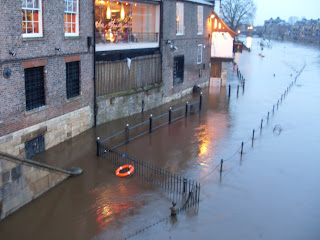By many a city, and by many a towne,
And many riuers taking vnder hand
Into his waters, as he passeth downe,
- The Faerie Queene, Edmund Spenser
And many riuers taking vnder hand
Into his waters, as he passeth downe,
- The Faerie Queene, Edmund Spenser
Never in his life had he seen a river before - this sleek, sinuous, full-bodied animal, chasing and chuckling, gripping things with a gurgle and leaving them with a laugh, to fling itself on fresh playmates that shook themselves free, and were caught and held again. All was a-shake and a-shiver - glints and gleams and sparkles, rustle and swirl, chatter and bubble.
- The Wind in the Willows, Kenneth Grahame
The centre of York is divided by the Ouse, a river whose name, according to some sources, stems from the Celtic word for water, usda. The modern name is pronounced as ooze. Ever since the city's foundation the river has served as an important transport route to the outside world, bringing Romans and Vikings into the heartland of Yorkshire, and allowing medieval merchants to establish a guild with connections to the European continent.
The first epigraph is a part of Edmund Spenser's description of the wedding of the rivers Thames and Medway, which converge at Rochester where Spenser was secretary to the Bishop John Young. The section is in essence a catalogue of the various rivers of Britain and the world coming to the bridal to pay their respects and tribute to the mighty Thames. The river epithalamion is a conceit harking back to Cygnea Cantio (1545) by John Leland and the fragmentary De Connubia Tamae et Isis (1586) by William Camden. The fragment quoted above did of course come to mind time and again in the course of my wanderings, particularly because the very idea of a river bridal is something I find very clever and apt to the merging of rivers.
When I first came to York the Ouse was running big with water from the snow that had melted prior to my arrival, and for the same reason its water was brown and heavy with silt, creating a beautiful contrast on days when the sky was azure and void of clouds.
This blogpost is, as the title indicates, dedicated to the river Ouse. On beautiful days it was pure bliss to walk along its banks and see its birdlife, the various boats cleaving its surface, and the very city itself mirrored in its never-ceasing flow of water. Sadly I have not travelled extensively down the river, but my walks have resulted in a nice set of photographs I would like to share.
Ouse Bridge from the King's Staith.
The river bank towards Skeldergate Bridge.
Skeldergate Bridge.
The Ouse at dusk, taken in January on one of my early days in York. The picture is taken close to Ouse Bridge shortly after the first flood.
Towards Ouse Bridge. The riverside was filled with silt which I, due to gross negligence of common sense, stepped into
With new rainfalls came new floods and even after the rain had ceased its legacy continued to put its mark on the city. I can no longer remember how many floods I witnessed during the weeks of January, but I recall the joy of seeing the riverbanks void of mud, only to have the hope of taking a long stroll destroyed in another flooding of waters. Fortunately the banks would always reemerge, and I can only blame myself for the walks not taken.
This is the music of memory, water.
- The Prodigal, Derek Walcott
Lendal Bridge
it could roar through town
foul-mouthed, brown-muscled, brazenly
drunk, a raucuous country-brookie
- The River, Derek Walcott
foul-mouthed, brown-muscled, brazenly
drunk, a raucuous country-brookie
- The River, Derek Walcott
Another walk I have not walked; at least not yet.
Still, it gets seer and hero across, and deposits them safely,
Over the waters, in shifting mud, amid grey river grasses.
- The Aeneid, Virgilius
Over the waters, in shifting mud, amid grey river grasses.
- The Aeneid, Virgilius
Most of my riverside walking was done by the Yorkshire Museum Gardens, itself separated from the riverbank by a fence. Consequently this particular area is the one best documented, but since it is a beautiful stretch of water I hope the reader will forgive my almost parochial repetitions.
What shulde I seyn? of foules every kinde
That in this world han fethres and stature,
Men mighten in that place assembled finde
Before the noble goddesse Nature,
And everich of hem did his besy cure
Benignely to chese or for to take,
By hir acord, his formel or his make.
- Parliament of Fowles, Geoffrey Chaucer
- Parliament of Fowles, Geoffrey Chaucer
More geese than swans now live, more fools than wise.
- The Silver Swan, anonymous poem from 1612
- The Silver Swan, anonymous poem from 1612
The following pictures were taken late on a February afternoon when I was on my way home from the main campus. While walking down the street towards Ouse Bridge I suddenly noticed that the water had crawled up on the embankment, flooding the houses by the river yet again. I had been told that in the days following such occasions one could see the water spout from the draining of the cellars, but unfortunately I didn't get to see it.
And it came to pass after seven days, that the waters of the flood were upon the earth.
- Genesis, 7:10
Kings Arms is a cozy little pub where the levels of past floods are marked on the wall. Evidently they are quite used to floods.
Après moi le déluge
- Louis XV of France


















































Ingen kommentarer:
Legg inn en kommentar